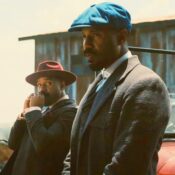The Wild Robot
⭐️ ⭐️ ⭐️ ⭐️
Rating: PG
Run Time: 1 hour 41 minutes
Stars: Lupita Nyong’o, Pedro Pascal
Writer/Director: Chris Sanders (From Peter Brown’s book series)
Reviewed at the Toronto International Film Festival
Big studio animation at its best, Dreamworks’ The Wild Robot references classic cartoons ranging from Bambi to The Iron Giant to offer a thrilling, thoughtful, thoroughly absorbing experience.
Grownups will love it; kids and grandkids will love it — and, unlike too many animated films, which approach dissociative personality disorder as they separately pander to both grownups and children, they’ll all love it for the very same reasons.
The Wild Robot wastes no time getting started: A robot (sweetly voiced by Lupita Nyong’o) washes ashore on a remote island and immediately finds herself at odds with the flesh-and-blood animal residents. Soon, she takes custody of an egg, which hatches a gosling, which immediately adopts the robot as its mother.
Since it is apparently the law that all 21st century cartoons must include a consciousness-raising premise, you could probably write the script from here: The robot will learn motherhood transcends genetics (and even life form), and the entire forest will learn a valuable lesson in cooperation, no matter if you’re a predator or prey.
Finally, you can bet your admission price that, before the final fade-out, someone will say something that approximates: “Families come in all kinds!”
So now that we’ve got that out of the way, we can focus on the visual and aural charms of The Wild Robot, a film that demonstrates a Hollywood truth that has held since Walt Disney unleashed The Seven Dwarfs: how comfortable it can be to place yourself in the hands of a studio that has been here before and done it as well as anybody.
I’ve still not quite forgiven Dreamworks Animation for pioneering the regrettable tendency of latter-day cartoons to infuse their scripts with soon-stale pop references and cheap-laugh scatological innuendo. Dreamworks’ cartoons have always looked great, but they’ve frequently seemed self-consciously raucous (and not in a good, anarchic Looney Tunes way). The Wild Robot foregoes jokiness for genuine emotion, offering an engaging story in an environment as rich as Disney at its most lavish.
More purely than any other film genre, animation reflects the vision of a director — in this case, Chris Sanders, a guy who, as writer, director, and animator, has been associated with some of the most distinctive cartoons of the past 30-plus years, including Beauty and the Beast, The Lion King, Lilo & Stitch and How to Train Your Dragon. The Wild Robot marks a natural progression from those earlier films, one in which the appealingly designed characters are matched by an environment that seems positively alive with crashing water, waving trees, and weather so masterfully rendered we can almost feel the whisper of a soft breeze and the pounding of torrential rainfall.
The Wild Robot’s island — thankfully, not a typical Madagascar-like tropical paradise but a pine-choked northern wilderness — is a place where we’d consider hanging out even if the robot never showed up. But the character provides nearly as many visual rewards as her surroundings do. With a big, round torso and a soccer ball-like head, the robot — who goes by the nickname Roz — can clamber up cliffs and leap across tree stump-strewn trails thanks to some delightfully adaptive arms and legs that instantaneously expand, retract, and adopt all manner of shapes, depending on the task at hand.
Designed as a household helpmate — and part of a doomed robot shipment that fell off a swamped freighter — Roz is programmed to determine her owners’ needs and then devise ways to fulfill them. Emerging from her crate, Roz presumes the island’s furry and feathered creatures are her new clients and, in a fantastically imaginative sequence, sits perfectly still for what seems like a year or two, patiently listening to each and every animal, learning their “languages.” When Roz finally rises to her feet, she can communicate fluently in native tongues from bird to bear.
As animals and robot become increasingly accustomed to — and fond of — each other, all is well. But after some time, the humans who built Roz come looking for her, and deep inside her circuits, the instinct to stay with her friends clicks into action.
Nyong’o calibrates nicely the challenging task of voicing a robot with a dawning sense of emotion, as if your phone’s Siri is slowly becoming genuinely concerned that you haven’t called your mother. Pedro Pascal infuses a fox named Fink with friendly chatter, and you’ll recognize the familiar tones of Bill Nighy as an old goose, Ving Rhames as a hawk, and Mark Hamill as a grizzly bear (who, in the film’s one slip into sentimental pandering, vows never to eat his new animal friends).
Best of all, the film — based on a series of books by Peter Brown — doesn’t settle for a typical cartoon storybook ending. Bittersweet at best, the fade-out honestly earns its tearful smiles.
Become a Saturday Evening Post member and enjoy unlimited access. Subscribe now



